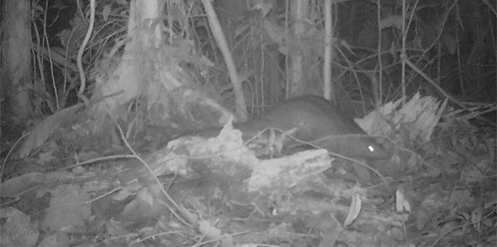June 25, 2018
Meet the Sunda Pangolin (Manis javanica), known in Indonesia as Trenggiling Peusing. The mammal, part of the Manidae (pangolin) family, is native to Southeast Asia. Besides Indonesia, it is found in Brunei, Cambodia, Laos, Malaysia, Myanmar, Singapore, Thailand and Vietnam.
It is one out of the 73 mammal species which have been identified in the Riau Ecosystem Restoration (RER) area within the Kampar Peninsula.
The Sunda Pangolin holds a critically endangered (CR) conservation status issued by the International Union for Conservation of Nature (IUCN), and is one of the only two critically-endangered mammals identified in RER.
The Sunda Pangolin’s body is covered with hard, overlapping plate-like keratin scales, which comprise 20 per cent of their body weight. It is the only known mammal with such scales.
The pangolin curls into a ball when threatened, tucking its face under its tail. The overlapping scales then act as armour to deter predators – particularly effective when the scales are also sharp.
The Sunda Pangolin has poor eyesight but a strong sense of smell. It has thick and powerful claws to dig into the ground to find ant nests or to tear into termite mounds. The pangolin can voluntarily constrict its ears and nostrils to keep the ants or termites out of them while it is feeding.

While it has no teeth, the pangolin has a long sticky tongue which can extend up to 25cm to trap and collect ants and termites. The pangolin can consume up to 200,000 ants a day, which means that it consumes more than 70 million insects per year.
The Sunda Pangolin prefers forested habitats – spending a large part of its life in trees – as well as plantations, such as rubber or palm oil plantations. It tends to mark its territory with urine or faeces, or another stinky secretion discharged from a special gland.
Known to be timid and nocturnal, the Sunda Pangolin is largely solitary, pairing up mainly only in the event that it needs to mate. Female pangolins typically give birth to only one or two offspring annually.
Baby pangolins are born with soft scales which harden rapidly. The young is carried on the back of the mother, just above the base of her tail, until they become older and independent.
The Sunda Pangolin is protected under Indonesian law, and is listed on Appendix I in CITES (Convention on the International Trade of Endangered Species), an international agreement between countries which governs the international trade of wild animal and plant species. CITES I species are those threatened with extinction.
The main threat to the Sunda Pangolin is human hunting and poaching for international trade – in fact, pangolins are deemed as the most trafficked animals in the world. It is wanted primarily for its scales and meat, driven by the mistaken belief that consumption of the animal will cure various ailments.
Human threat to the species is so widespread that in a bid to raise public awareness about the species’ plight, World Pangolin Day was established in 2012 and is now observed each year on the third Saturday of February.